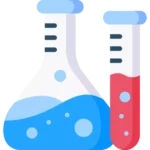Guess Paper Biology Class 11 is up-to-date and the most important questions are given according to Punjab boards. These guess papers will help you get the highest marks on your papers. Punjab Board guess paper Biology is relevant to all chapters, and we have tried to include all the necessary questions to help students score more than seventy percent.
11th class Biology Guess Paper by Ahsa.Pk is available and you may ask if you need any assistance from our qualified team. Biology Class 11 guess papers are for helping material that may enhance the student’s chances of getting more marks in less time.
Guess Paper Biology Class 11
11th Class Biology Important Short Questions
Chapter 1
- What is a biome?
- What is the hydroponic culture technique?
- Differentiate between inductive and deductive reasoning.
- Differentiate between micro and macromolecules.
- Write the names of four eras of geological times.
- What is phyletic lineage?
- Define theory. Give important features of a good theory.
- Define population and give its example.
- Define parasitology.
- Differentiate between anatomy and morphology.
- Define the ecosystem with an example.
- Differentiate between gene therapy and chemotherapy.
Chapter 2
- What is the heat capacity of water? Give its importance.
- Define the protective role of water.
- Differentiate between Amylose and Amylopectin.
- Differentiate between glycosidic and peptide bonds.
- What are oligosaccharides?
- What are lipids?
- What are waxes? Give two roles of waxes.
- Give the general formula for an amino acid.
- Differentiate between nucleoside and nucleotide.
- What is phosphodiester linkage? Draw structure.
Chapter 3
- How is the prosthetic group different from the co-enzyme?
- Differentiate between co-factor and co-enzyme.
- Differentiate between pepsin and pepsinogen.
- Differentiate between co-factor and activator.
- Define enzymes.
- Give the role and examples of enzyme activators.
- Define co-factor with an example.
- Give any two characteristics of enzymes.
- What are globular proteins? Give examples.
- Define the lock and key model of enzymes.
- Differentiate between reversible and irreversible enzyme inhibitors.
- What are competitive and non-competitive enzyme inhibitors?
Chapter 4
- Write two salient features of cell theory.
- What is endocytosis?
- Differentiate between phagocytosis and pinocytosis.
- Define differentially permeable membrane.
- What are the storage diseases? Give an example.
- Give the important functions of cytoplasm.
- What is chromoplast? Give its functions.
- Give the chemical composition of the primary and secondary cell walls.
- What are microfilaments? Give its functions.
- Define the fluid mosaic model of the cell membrane.
- Write two functions of the Golgi apparatus.
- Give the function of the endoplasmic reticulum.
- Define autophagosome.
- What is the resolution of the human eye and electron microscope?
Chapter 5
- Write down four characteristics of viruses.
- Define species and virology.
- What are pocks?
- What are prions and viroids?
- Write four names of viral diseases common in human beings.
- Define binomial nomenclature. Give example.
- What are the symptoms of smallpox?
- Differentiate between prokaryotic and eukaryotic.
- Sketch and label diagrams of bacteriophage.
- Write down five postulates of the germ theory of disease by Robert Koch.
Chapter 6
- Differentiate between gram-positive and gram-negative bacteria.
- Name three shapes of bacteria. Explain only one.
- Write misuses of antibiotics.
- Differentiate between terad and sarcina.
- What are pilli and give their functions?
- Differentiate between lophotrichous and amphitrichous.
- Differentiate between streptococcus and staphylococcus bacteria.
- Differentiate between amphitrichous and peritrichous bacteria.
Chapter 7
- What is sleeping sickness?
- Write down the functions of micro and macronuclei in ciliates.
- Write down four characteristics of green algae similar to plants.
- Differentiate between fungi and oomycetes.
- What are choanoflagellates?
- What are protists? How are they different from animals and plants?
- What are trichonymphas?
- How do algae differ from plants?
- Write down two characteristics of ciliates.
- How ciliates are different from other protozoans?
- Write down two characteristics of apicomplexans.
- What is chlorella? Give its importance.
- Write down two characteristics of dinoflagellates.
- Write four important features of algae.
- How do flagellates get food?
Chapter 8
- Enlist four plant diseases caused by fungi.
- Differentiate between obligate and facultative parasites.
- Name the type and hyphae and sexual spores in sac fungi.
- Write down two similarities between plants and fungi.
- What are carnivorous fungi?
- Write four important points of algae.
- Differentiate between fungi like protists and fungi.
- What is histoplasmosis?
- Why rust and smut are called so?
- What is nuclear mitosis?
- What are lichens? Write about their ecological role.
- Define lichens. Give its significance.
- Differentiate between plasmogamy and karyogamy.
- What are sepatate and non-septate hyphae?
- What do you know about budding and pansexuality?
- What are conidia and spores?
- What is meant by parasexuality? Give its importance.
- Differentiate between conidiophores and coenocytic hypha.
- Differentiate between ascus and basidium.
- What are toadstools? Give example.
Chapter 9
- Differentiate between ovule and seed.
- Why bryophytes are called amphibious plants?
- Differentiate between microphyll and megaphyll.
- Define double fertilization.
- Write down two steps involved in the evolution of seed.
- Describe the adaptation of bryophytes to land habitat.
- Write two advanced characteristics of Anthoceropsida sporophyte.
- What are gymnosperms? Give an example.
- Differentiate between bryophytes and tracheophytes.
- Define cercinate vemation.
- Define ovule and embryo sac.
- What are fronds?
- Write the botanical name of two plants belonging to the family Solanaceae.
- Differentiate between microgametophyte and megagametophyte.
Chapter 10
- What is a hermaphrodite organism?
- Write basic characteristics of chordates, and give examples.
- What are cord reefs?
- Define swim bladder. Give its functions.
- What is regeneration? Give example.
- What are diploblastic animals?
- Define placenta. Write its functions.
- Write the two differences between protostomes and deuterostomes.
- Differentiate between gastropods and cephalopods.
- What is regeneration? Give its importance.
- Name four harmful effects of insects.
- Give three basic characteristics of phylum chordate.
- What is polymorphism? Give example.
- Differentiate between sac-like and tube-like digestive systems.
- What is metamorphosis?
- Differentiate between parazoa and eumetazoa.
- What is archaeopteryx? Give its two characteristics.
- Differentiate between polyps and medusas.
- Differentiate between diploblastic and triploblastic organisms.
- Write down affinities of echinoderm with hemichordates.
Chapter 11
- Give the importance of ATP.
- Define the term Bioenergetics.
- What is glycolysis? Where does it take place in cells?
- How action spectra can be obtained?
- What is cellular respiration?
- What is the payoff phase of glycolysis?
- How is carbon dioxide absorbed by the cell wall of mesophyll cells?
- Define photosynthesis with an equation.
- What do you mean by action spectrum?
- What are accessory pigments? Give their one importance.
- What is fermentation? Give its two types.
- Differentiate between antenna complex and reaction center.
- Give the function spectrophotometer.
- Define glycolysis. Where does it take place?
- Write the photolysis of water in photosynthesis.
- What is Z-scheme of photosynthesis?
- Differentiate between photophosphorylation and oxidative photophosphorylation.
- Define alcoholic fermentation. Write its equation.
Chapter 12
- What is chlorosis and what is their cause?
- What are the main reason of chlorosis in plants?
- Discuss parasitic nutrition in plants.
- What are root nodules? Give their role.
- What is detritus feeding? Give examples.
- What is filter feeding?
- What are fluid feeders? Give example.
- Differentiate between facultative and obligate parasites.
- Define gastrovascular cavity with example.
- Define sac like digestive system and tube like digestive system regarding their efficiency.
- Differentiate between Herbivores and Carnivores.
- Differentiate between ingestion and Egestion.
- Differentiate between detritivores and omnivores.
- Differentiate between absorption and assimilation.
- Write only two functions of oral cavity.
- Define peristalsis.
- What is the advantages of a digestivetract as compared with a digestive cavity?
- Differentiate between chyme and bolus.
- Describe the role of trypsin in digestion.
- Give two functions of human liver.
- What is bile? Give its functions.
- Define Villi? write down functions of Villi.
- Give the role of the large intestine of humanss.
- What is Dyspepsia?
- How adipose tissue is formed?
- Write down the causes and treatment of anorexia nervosa.
- What is an ulcer?
- Write only two functions of the oral cavity.
Chapter 13
- What is Rubisco? Give its functions.
- What are spiracles? Give their functions.
- How air is a better medium for respiration than water.
- What is asthma? Give its cause.
- Write different ways of respiration in frogs.
- What is the larynx or voice box?
- What is the diaphragm? In which group of animals it is found?
- Differentiate between bronchi and bronchioles.
- What is emphysema?
- Write two properties of respiratory surfaces.
- What is respiratory distress syndrome?
- What is the diving reflex?
- What is lung cancer?
- Why oxygen can be easily obtained from the air as compared to water?
- How does respiration take place in earthworms?
- What are alveoli? Give their functions.
- Give the composition of breath air in humans.
- Give two properties of respiratory surfaces in animals.
- What is photorespiration?
- Differentiate between pulmonary and cutaneous respiration.
Chapter 14
- What is guttation?
- Define immunity.
- Differentiate between active and passive immunity.
- Differentiate between plasmolysis and deplasmolysis.
- What is a single-circuit heart? Give an example.
- Differentiate between apoplast and symplast pathway.
- What is pressure potential?
- What are blue babies?
- What is pressure flow theory? Who proposed it?
- Differentiate between single and double-circuit hearts.
- What is a humoral immune response?
- Differentiate between thrombus and embolus.
- Describe CO2 concentration in artery and venous blood.
- What is imbibition?
- What is honeydew? Give its composition.
- What are the factors affecting the capacity of hemoglobin to combine with oxygen?
- What do you know about bleeding in plants?
- What is cell-mediated and humoral immune response?
Click Here for 1st Year Biology MCQs
11th Class Biology Important Long Questions
- How study of biology helped mankind to improve the production of food?
- Soil water moves and reaches xylem tissues by various pathways, explain.
- What is the role of the study of Biology in the welfare of mankind in the field of protection and conservation of the environment?
- Discuss two main types of immunity.
- Give various components and functions of the Lymphatic System.
- Discuss transpiration as a necessary evil.
- Explain mutualistic nutrition in fungi.
- Describe the biological properties and importance of water.
- Describe asexual reproduction in fungi.
- What are polysaccharides? Describe different types and give examples.
- Explain various economic gains and losses due to fungi.
- Write the Watson and Crick model of DNA.
- Explain about use and misuse of antibiotics.
- Describe the different adaptive characteristics of terrestrial environment in bryophyte.
- Discuss nutrition in bacteria.
- Discuss the evolution of the megaphyll leaf.
- Describe habitat, structure, and reproduction in nostoc.
- Describe the prothallus of adiantum. What is an alternation of generation? Give its significance.
- Describe some viral diseases, which are common in Pakistan.
- What is photophosphorylation? Explain non-cyclic photophosphorylation.
- What is hepatitis? Give its symptoms and discuss its three common types.
- Give in detail the phases of the Calvin cycle.
- Describe the Iytic cycle of bacteriophage (with diagram).
- Sketch Krebs Cycle, (no description).
- Discuss the structure and functions of the endoplasmic reticulum.
- Give the role of the large and small intestines in human beings.
- What are plastids? Explain the structure and function of a chloroplast. Draw figure.
- Describe digestion in hydra.
- What are lysosomes? Explain their phagocytic role with the help of a diagram.
- Discuss the process of nutrition in insectivorous plants.










